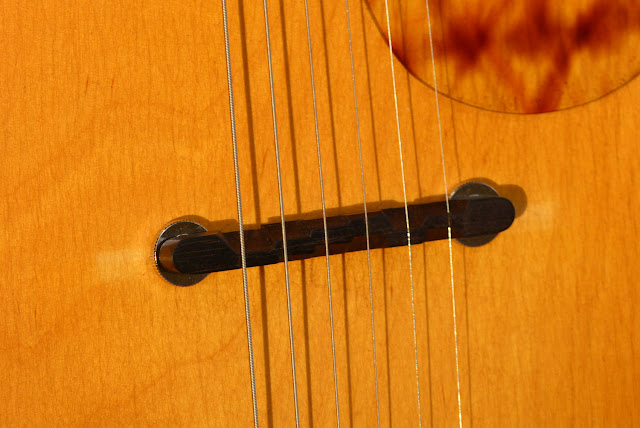1950s United-made Howard Electrified 000-Size Flattop Tailpiece Guitar
I admit it: I have a bit of a thing for United-made products. For example, see here, also here, here too, and here as well. While the company was capable of making quite high-quality instruments (see Premier), they're mostly known for their sprawling range of plywood-bodied student guitars and mandolins which were sold under any number of brand-names.
This one has a "Howard" moniker at the headstock and it's the first United ply student guitar that I've seen in a "full size" format -- that being an L-00-ish body shape that's 15 1/4" on the lower bout, sporting a 14-fret neck joint, and tailpiece load. United's student range had the benefit of pretty stable and relatively comfortable necks. The same style guitars made by Kay and Harmony in Chicago tend to have much clunkier necks, whereas I actually enjoy the necks on these for things other than cowboy chords. They also have a full 25" scale length which puts them in the realm of Gibson/Martin territory.
I have a penchant for putting electric pickups on these old Uniteds (see here), so after doing work on it (which included a neck reset, fret level/dress, seam repairs, setup, and a new compensated and adjustable bridge), I installed a new Korean-made full-size Danelectro-style lipstick pickup in the soundhole with a hot (8k ohms) output. A simple volume control and jack complete the wiring harness at the lower-bout top. Strings are 46w, 36w, 26w, 18w, 14, 10 but the guitar would be happy and healthy up to 52w-11 gauges. The bridge is compensated for a wound G, however, to keep it "authentic" in vibe (and sounding swell acoustically).
It plays on-the-dot with 3/32" E and 1/16" ADGBE action at the 12th fret and, as you can hear in the soundclip, it's pretty dang easy to move around on it. The acoustic sound is reminiscent of a cheap/funky archtop guitar and quite midsy but with a good, lower-mids chunk. It's decently loud. The electric sound is excellent -- it's definitely Danelectro Convertible in vibe, but the hotter pickup gives it more girth on the low-end. With a clean amp you can simulate the "soundhole pickup acoustic" sounds of yesteryear and with a driven amp you can get a nice, rich, folk-rock/bluesy/Americana voicing. Still -- being a lipstick pickup, notes don't muddy-up into one another as you add gain, so it's ideal as a chord-banger.
The whole body is 3-ply birch and the face of it is natural (a yellowy-buttery color) while the back and sides are a dark, browny-grey color. The "binding" is all painted-on, but the firestripe pickguard is real-deal celluloid and looks sweet.
The poplar neck is topped with a flat-profile stained-maple (I think) fretboard. The nut is original but the tuners are new Kluson-style repro units that work great.
The nut is 1 3/4" in width and the back of the neck has a middling-sized C-profile to it.
The original frets are low-ish and brass, but the neck is straight and the level/dress job means everything's accurate. I added side dots, too.
The new bridge is ebony, compensated, and adjustable for height.
The original tailpiece setup made it easy to ground the wiring harness.
The controls are way down on the lower bout and out of the way. I usually just use my volume control as a mute when swapping instruments, so to me it's an advantage down here. The top-mounted jack also makes it easy to find it. Don't you hate it when you're grubbing around for it on the side for 30 seconds? I use a right-angle jack on a guitar like this and then loop the cord through my strap to keep it tidy.
The neck was reset traditionally (glue and shims), so while I often also bolt a neck of this caliber as well, the strap button is simply that -- an anchor for your strap and doing no structural work.




















Comments